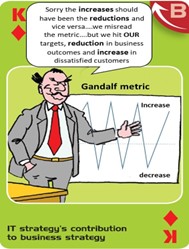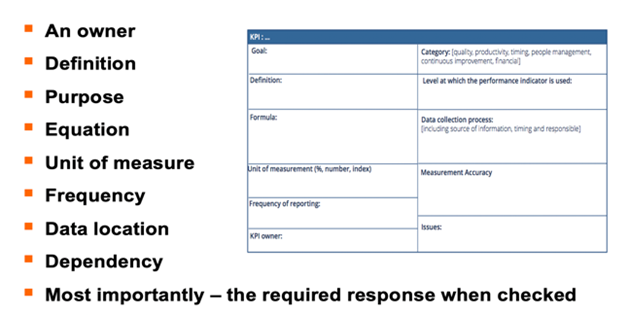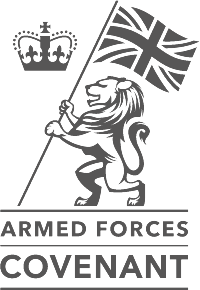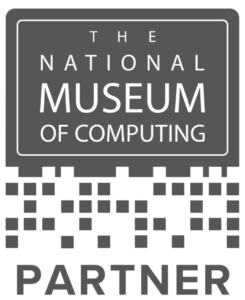- KPI: KEY Performance Indicators
- OKR: Outcomes or Objectives that are KEY to a Result
Confused? Do you have these metrics? Are they working for you?
When Paul Wilkinson wrote his blogs on The Shiny New Thing That Helps, I noticed he had no metric to judge whether #TSNTTRH was doing any good. So, I created #OMTRTA as an adjunct to his posts: One Metric to Rule them All! One measure that the organisation could use to obtain focus. Paul liked the idea, so based on his fantastic concept of Attitude, Behaviour and Culture (#ABC) cards, Paul drew a card for #OMTRTA.

Let’s talk measures!
Everyone loves a measure. It proves our work, shows us direction, acts as a guide and more.
I like playing with word phrases, so here is an exercise:
- Say KPI to yourself, even spell out Key Performance Indicator. Think about what this means to you. How many do you have? Loads? Which one is KEY?
- Now say Indicator of Performance that is KEY. Emphasise the word KEY. Which phrase means more or is closer to your expectation of a KEY metric?
It doesn’t matter if you use OKR or some other phrase, the same tactic works. Change the order, and the meaning becomes more relevant. Steve Bell, my lean guru, taught me that measures are the things that make the invisible visible. I love this view. Be they KPI or OKR, if they are not helping you observe behaviour you had not noticed, or helping you improve, or highlighting that a target you want to hit is going to be missed, then the measure is not KEY. It is just a number.
Think about this as you strive to transform your organisation in new ways of working (creating products or services) to satisfy customers or help staff perform their roles. Digital Transformation is the rave, but how do you know that you have transformed?
Metrics help us visualise the value and performance of what we are attempting. Key metrics act as guides and indicate if we are on target or at least heading in the right direction. Think about sailors in a rowing race across the Atlantic. They have several measures (number of strokes per hour, team members’ health, amount of food or drink left, will we arrive on time, etc.), and the OMTRTA is ‘Are we on target for our destination’? All the other measures support OMTRTA!
Value chains
Everyone is also talking about value chains or streams. ITIL, DevOps, Lean, Agile, leadership, everyone!! Value Stream Mapping and Management (you have to do both folks) looks at all of the activities involved from the time you begin something (demand or request) until it is in the hands of the customer or consumer. You measure actual time, wait time, data movement, meetings, people involved, tools involved and other things depending on the stream. Now step back, look and ask if the invisible just became clear – “hey, this is slowing us down and this and, oh, wait, this as well”. No wonder our OMTRTA of staff and customer satisfaction is consistently being missed.
The secret of OMTRTA!
The secret of OMTRTA is discussion and visualisation!
If you do not have a discussion to explain:
- the importance of OMTRTA
- a way to visualise the impact of what is occurring now versus expectation
- with an understandable way of defining and calculating the measure
- and an agreed action of what to do if not on target…
… then you have a metric that will not show the invisible or help modify behaviour. You will not have a KEY that allows you to quickly visualise good, bad or great activity, effort and success.
Leaders – some tips!
To create OMTRTA, start a discussion and create a story. Leaders DO NOT begin the story. You can relate a vision, but the OMTRTA must be set at each level (team or department) without you telling them what OMTRTA must be. Otherwise, whatever you say will be the target, good or bad, believed or not believed.
You need to facilitate the group to tell the story and design the pictures that visualise that story. You need to generate enthusiasm for the experiments (guesses) on what behaviour they will alter to make OMTRTA.
With your visual maps, add this story format borrowed from mentors Barry O’Reilly and Jeff Gothelf:
- We believe (state the vision like “our bank will invest in benefitting from digital transformation”)
- This will result in (list no more than two things you want to accomplish. No more than two as this is just a hypothesis you are writing)
- We will have the confidence we’ve succeeded when (list a measurable and agreed goal like customers invest in our new services or our new product portfolio increases our customer numbers by 30% in 3 years, no more than 3-5 of these)
- We will monitor our progress on a (weekly, daily, hourly) basis and if we are missing the goal, we will (set defined actions).
Do you see what happened? You didn’t make the error of starting with the last statement: increase customers. You got the team to indicate the what, why, and how to obtain OMTRTA. They better understand what they can and cannot do towards OMTRTA. The group feels it is their goal. They want to do this, and they feel that leaders have their backs.
Visualise your metrics
KPI/OKR need a dashboard to monitor and alert the status of KEY. Not a monthly report, but an active monitor – see it, agree on it, and work towards it. Place these cards, each with their story, on a board or in a tool or on your intranet – and let others comment! Scale will occur as you link goals (nest), and the transformation will occur.

Final thoughts
Chris Dancy tweeted, “We don’t know how to measure what we care about, so we need to care about what we measure.” Paul Wilkinson with his Shiny New Thing framework agrees. Your measurement must be valuable and have an outcome that focuses the organisation on the result.
For me, income or cost are not OMTRTA. Financial measures are results and may or may not be KEY. Staff satisfaction is my OMTRTA. Mental health, job satisfaction, an understanding of what you need to do today to ensure that tomorrow you have a job or can help a customer or another team member: these are my important KEY OMTRTA.
What is your #OMTRTA? Why?



